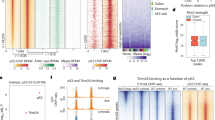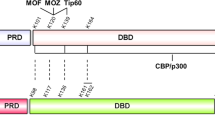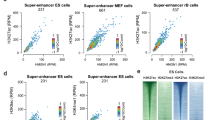Abstract
We have used chromatin immunoprecipitation (ChIP) to measure p53-dependent histone acetylation at the p21, MDM2, and PUMA promoters. The pattern of histone acetylation was different at each promoter. H3 and H4 acetylation increased at both the p21 and PUMA promoters in response to p53 activation, whereas there was only a minimal increase in H4 acetylation and no increase in H3 acetylation at the MDM2 promoter. The high p53 occupancy of the p21, MDM2 and PUMA promoters has been attributed to the presence of two p53 binding sites in these promoters, but mutation of the p53 binding sites in integrated p21 promoter constructs showed that the two sites in the p21 promoter do not cooperate to stabilize p53 binding. Despite 10-fold higher p53 binding to the proximal than the distal site in the p21 promoter, both sites showed similar patterns of H3 and H4 acetylation. Mutation of the binding sites showed that acetylation of the proximal, low-affinity site requires p53 binding to that site but not to the distal, high-affinity site. Since low-affinity p53 binding sites can confer strong acetylation, the DNA binding affinity in vitro is an unreliable guide to the likely importance of p53 in regulating candidate target genes in vivo.
This is a preview of subscription content, access via your institution
Access options
Subscribe to this journal
Receive 50 print issues and online access
$259.00 per year
only $5.18 per issue
Buy this article
- Purchase on Springer Link
- Instant access to full article PDF
Prices may be subject to local taxes which are calculated during checkout





Similar content being viewed by others
References
Agalioti T, Chen G and Thanos D . (2002). Cell, 111, 381–392.
Anderson CW and Appella E . (2003). Handbook of Cell Signaling, Bradshaw RA, Dennis E (eds). Vol. 3. Academic Press, pp 237–247.
Ard PG, Chatterjee C, Kunjibettu S, Adside LR, Gralinski LE and McMahon SB . (2002). Mol. Cell Biol., 22, 5650–5661.
Barlev NA, Liu L, Chehab NH, Mansfield K, Harris KG, Halazonetis TD and Berger SL . (2001). Mol. Cell, 8, 1243–1254.
Biggs JR, Kudlow JE and Kraft AS . (1996). J. Biol. Chem., 271, 901–906.
Bridge AJ, Pebernard S, Ducraux A, Nicoulaz AL and Iggo R . (2003). Nat. Genet., 34, 263–264.
Bunz F, Dutriaux A, Lengauer C, Waldman T, Zhou S, Brown JP, Sedivy JM, Kinzler KW and Vogelstein B . (1998). Science, 282, 1497–1501.
Candau R, Scolnick DM, Darpino P, Ying CY, Halazonetis TD and Berger SL . (1997). Oncogene, 15, 807–816.
Chehab NH, Malikzay A, Stavridi ES and Halazonetis TD . (1999). Proc. Natl. Acad. Sci. USA, 96, 13777–13782.
Chen X, Ko LJ, Jayaraman L and Prives C . (1996). Genes Dev., 10, 2438–2451.
Dumaz N and Meek DW . (1999). EMBO J., 18, 7002–7010.
el-Deiry WS, Kern SE, Pietenpol JA, Kinzler KW and Vogelstein B . (1992). Nat. Genet., 1, 45–49.
el-Deiry WS, Tokino T, Velculescu VE, Levy DB, Parsons R, Trent JM, Lin D, Mercer WE, Kinzler KW and Vogelstein B . (1993). Cell, 75, 817–825.
el-Deiry WS, Tokino T, Waldman T, Oliner JD, Velculescu VE, Burrell M, Hill DE, Healy E, Rees JL and Hamilton SR . (1995). Cancer Res., 55, 2910–2919.
Espinosa JM and Emerson BM . (2001). Mol. Cell, 8, 57–69.
Espinosa JM, Verdun RE and Emerson BM . (2003). Mol. Cell, 12, 1015–1027.
Freeman J, Schmidt S, Scharer E and Iggo R . (1994). EMBO J., 13, 5393–5400.
Halevy O, Novitch BG, Spicer DB, Skapek SX, Rhee J, Hannon GJ, Beach D and Lassar AB . (1995). Science, 267, 1018–1021.
Ikura T, Ogryzko VV, Grigoriev M, Groisman R, Wang J, Horikoshi M, Scully R, Qin J and Nakatani Y . (2000). Cell, 102, 463–473.
Ito M, Yuan CX, Malik S, Gu W, Fondell JD, Yamamura S, Fu ZY, Zhang X, Qin J and Roeder RG . (1999). Mol. Cell, 3, 361–370.
Jackson P, Mastrangelo I, Reed M, Tegtmeyer P, Yardley G and Barrett J . (1998). Oncogene, 16, 283–292.
Kaeser MD and Iggo RD . (2002). Proc. Natl. Acad. Sci. USA, 99, 95–100.
Kaeser MD, Pebernard S and Iggo RD . (2004). J. Biol. Chem., 279, 7598–7605.
Klein C, Planker E, Diercks T, Kessler H, Kunkele KP, Lang K, Hansen S and Schwaiger M . (2001). J. Biol. Chem., 276, 49020–49027.
Lee D, Kim JW, Seo T, Hwang SG, Choi EJ and Choe J . (2002). J. Biol. Chem., 277, 22330–22337.
Liu M, Lee MH, Cohen M, Bommakanti M and Freedman LP . (1996). Genes Dev., 10, 142–153.
Lutzker SG and Levine AJ . (1996). Nat. Med., 2, 804–810.
Rowan S, Ludwig RL, Haupt Y, Bates S, Lu X, Oren M and Vousden KH . (1996). EMBO J., 15, 827–838.
Sakaguchi K, Herrera JE, Saito S, Miki T, Bustin M, Vassilev A, Anderson CW and Appella E . (1998). Genes Dev., 12, 2831–2841.
Saller E, Tom E, Brunori M, Otter M, Estreicher A, Mack DH and Iggo R . (1999). EMBO J., 18, 4424–4437.
Stenger JE, Tegtmeyer P, Mayr GA, Reed M, Wang Y, Wang P, Hough PV and Mastrangelo IA . (1994). EMBO J., 13, 6011–6020.
Sterner DE and Berger SL . (2000). Microbiol. Mol. Biol. Rev., 64, 435–459.
Szak ST, Mays D and Pietenpol JA . (2001). Mol. Cell Biol., 21, 3375–3386.
Thut CJ, Chen JL, Klemm R and Tjian R . (1995). Science, 267, 100–104.
van de Wetering M, Sancho E, Verweij C, de Lau W, Oving I, Hurlstone A, van der Horn K, Batlle E, Coudreuse D, Haramis AP, Tjon-Pon-Fong M, Moerer P, van den Born M, Soete G, Pals S, Eilers M, Medema R and Clevers H . (2002). Cell, 111, 241–250.
Vogelstein B, Lane D and Levine AJ . (2000). Nature, 408, 307–310.
Vousden KH and Lu X . (2002). Nat. Rev. Cancer, 2, 594–604.
Winkler GS, Kristjuhan A, Erdjument-Bromage H, Tempst P and Svejstrup JQ . (2002). Proc. Natl. Acad. Sci. USA, 99, 3517–3522.
Yewdell JW, Gannon JV and Lane DP . (1986). J. Virol., 59, 444–452.
Zhao R, Gish K, Murphy M, Yin Y, Notterman D, Hoffman WH, Tom E, Mack DH and Levine AJ . (2000). Genes Dev., 14, 981–993.
Zufferey R, Dull T, Mandel RJ, Bukovsky A, Quiroz D, Naldini L and Trono D . (1998). J. Virol., 72, 9873–9880.
Acknowledgements
We thank Drs B Vogelstein, D Lane, D Trono, C Prives, and E Saller for supplying cell lines, antibodies and plasmids. We thank Dr V Simanis for critical reading of the manuscript. We thank the Swiss National Science Foundation for financial support.
Author information
Authors and Affiliations
Corresponding author
Rights and permissions
About this article
Cite this article
Kaeser, M., Iggo, R. Promoter-specific p53-dependent histone acetylation following DNA damage. Oncogene 23, 4007–4013 (2004). https://doi.org/10.1038/sj.onc.1207536
Received:
Revised:
Accepted:
Published:
Issue Date:
DOI: https://doi.org/10.1038/sj.onc.1207536
Keywords
This article is cited by
-
Efficient generation of brain organoids using magnetized gold nanoparticles
Scientific Reports (2023)
-
The multiple mechanisms that regulate p53 activity and cell fate
Nature Reviews Molecular Cell Biology (2019)
-
Phospho-ΔNp63α is a key regulator of the cisplatin-induced microRNAome in cancer cells
Cell Death & Differentiation (2011)
-
Effect of hydroxyurea on the promoter occupancy profiles of tumor suppressor p53 and p73
BMC Biology (2009)
-
p53 induces distinct epigenetic states at its direct target promoters
BMC Genomics (2008)



